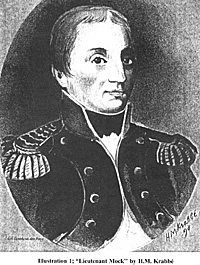The Siege of Maastricht: 1793
The Dutch During
The Revolutionary Wars: 7
Introduction
by Geert van Uythoven, The Netherlands
| |
As already described in my previous article, part of Miranda's Armée du Nord would besiege Maastricht, one of the strongest fortresses in the Dutch Republic. Governor of the garrison was Lieutenant-General Prins Frederik van Hessen-Kassel, Colonel of the Regiment Dragonders Van Hessen-Kassel. As we will see, this would be the right man at the right place during the upcoming siege. The garrison was formed by the following units: The besieging French army was about 25,000 strong, and divided in two parts; the troops on the east bank of the river Meuse were commanded by Lieutenant-General Alexis-Paul-Michel Tanneguy, comte Le Veneur de Tilliéres, and the troops on the west
bank under Louis-Philippe d'Orléans, duc de Valois and duc de Chartres. The siege was led by the chef du génie of the Armée des Ardennes, de very experienced Lieutenant-general Benoît-Louis Bouchet, who had besieged beside many other cities including Namur a few months
previous, also Maastricht earlier, during the war of 1747. The besieging troops were covered by about 35,000 to 40,000 men, dispersed in cantonments over a wide area, commanded by Lieutenant-General compte de Valence (commanding the Armée des Ardennes), and Lieutenant-General chevalier de la Noue (commanding the Armée de la Meuse). They on their turn were covered by an advance guard of about 18,000 men, commanded by maréchal de camp Henri-Christian-Michel, baron de Stengel.
The siege of Maastricht is vividly described in the journal of Gabriël Mock, serving during the siege as a 2nd Lieutenant in the 2nd company of the Dutch 3rd artillery battalion. The journal is included in "Het Historisch Museum van het Korps Rijdende Artillerie", part I by N.J.A.P.H. van Es (Arnhem 1898). For a change, and because of the importance of this journal, I will describe the siege by translating Mock's journal. Mock
describes the events through the eyes of someone who stood close to the soldiers and citizens of Maastricht, finding himself on the receiving end of an intensive bombardment, without closing his eyes for the misery caused by the siege to the citizens. His journal gives a magnificent insight how life was in a besieged city, and what the influence of a brave and determined commander was on the garrison and the citizens alike.
"The city Maastricht was invested by the French on 5 February, but not so closely that no one could leave or enter the city. The postal service rode and left as usual. The villages and the environs were occupied by [French] troops, but until now only small detachments. However, these became stronger every day, and we heard that the detachments were also expanded. On 8 February, the post destined for Holland was again [sic!] returned by the French, so we could not send or receive letters to or from Holland anymore. Therefore, we could not receive any information from the outside, and the city was isolated. From the country-people who managed to enter the city following detours, we heard that French reinforcements arrived all the time, but until now we received no information about the approach of French heavy cannon other then their regimental guns. Every day we observed marching cavalry and infantry, a long distance from the city.
There were no hostilities, only the 'Sauve-gardes', that we had given to the villages were taken away and not respected, something that was unheard of until now. Every day we received intelligence that the enemy was busy in the surrounding woods with the construction of fascines and other accessories destined for their entrenchments against our fortress. The enemy became more forward every day, but they never dared to undertake anything against our patrols. Every time they became aware of our approach, they retreated in haste. All the time we heard the farmers and country-people complain about the behaviour of the French troops, who allowed no one to transport anything to the city, and requisitioned everything. We tried to secure as much provisions as we could. Here then follows their first encounter with our troops."
Siege of Maastricht 1793
The Dutch During the Revolutionary Wars
|
 Illustration 1: "Lieutenant Mock" by H.M. Krabbé
Illustration 1: "Lieutenant Mock" by H.M. Krabbé